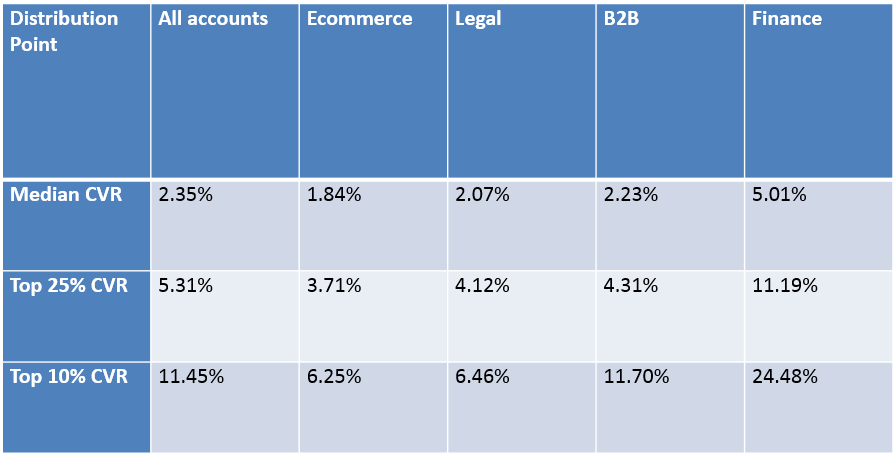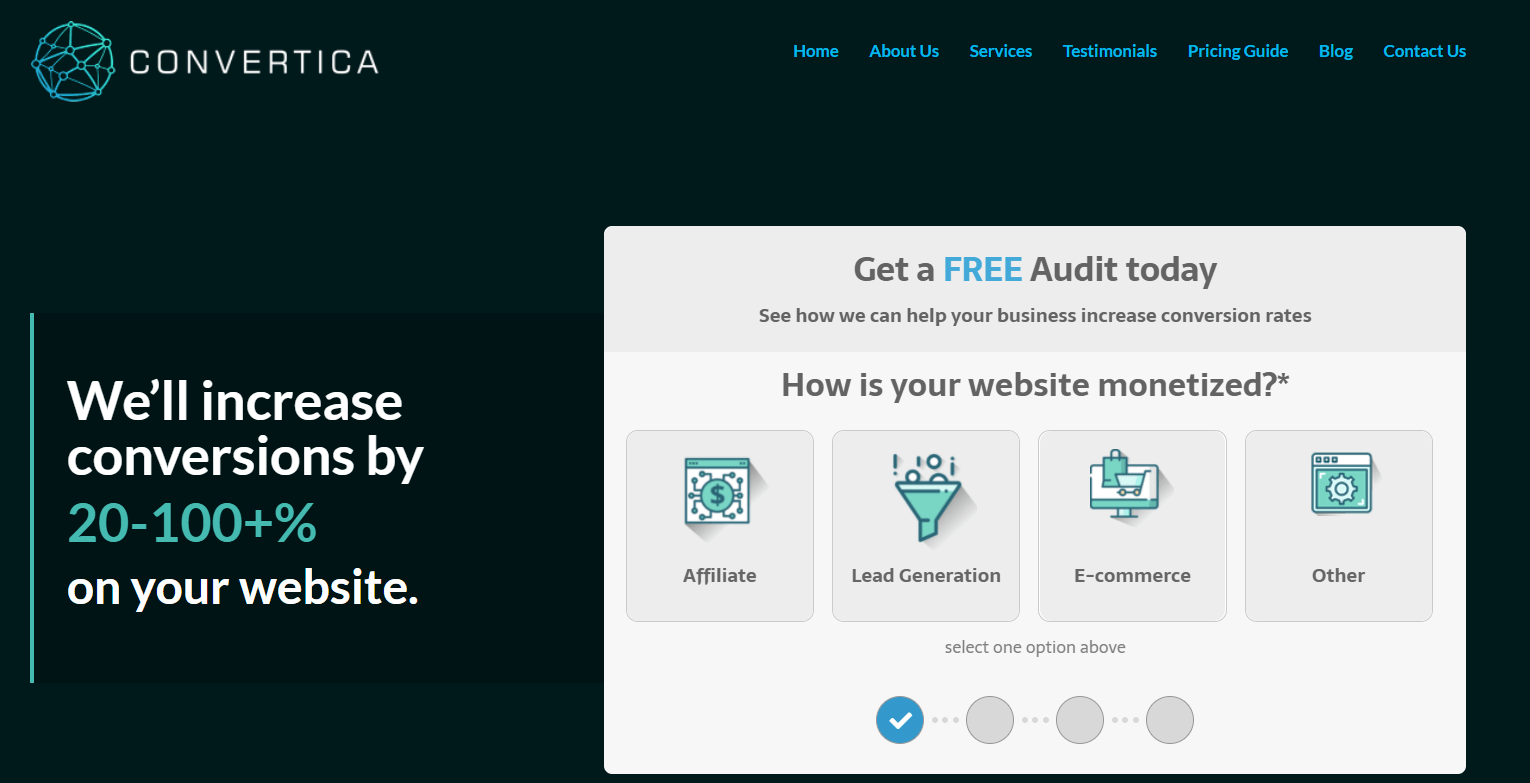
Improve Your Conversion Rate Optimization With This CRO Checklist
Or maybe you’re just looking for a practical list of conversion elements to test on your landing page?
Hopefully, our conversion rate optimization checklist can help you out.
One common school of thought in the world of conversion rate optimization is that the more things you can identify to A/B test on your site – the better.
At the same time, you should be identifying elements to test that make a difference and can bump up the conversion rate considerably. Instead of making small, minor changes (like a different hue color of a button), one-by-one that can only improve your CR ever so slightly.
Across industries, the average landing page conversion rate is around 2.35%. Yet, the top 25% are converting at 5.31% or higher. Ideally, you want to break into the top 10% – where the conversion rate can go as high as up to 11.45%+.

If you need more concrete information and a benchmark, consider looking into the average conversion rate for your industry.
And as you might have guessed – the only way to get there is through constant CRO tests and refining your offer until you struck gold.
Now, yes, it’s true. There are a lot of factors and elements you need to take into account when doing conversion rate optimization.
But hopefully, this checklist can save you a lot of trouble by providing a super actionable approach to CRO. Here’s what we’ll cover:
- General Landing Page Optimization Checklist
- SaaS Conversion Rate Optimization Checklist
- eCommerce Optimization Checklist
- Conversion Rate Optimization Audit
Feel free to jump ahead to your industry section if you’re looking for something more specific
General Landing Page Optimization Checklist
First things first – let’s take a look at some best practices for general landing page conversion rate optimization.
Most landing page layouts use the following structure:
- A main headline and a supporting headline (hero section).
- Strong offer or unique selling proposition (USP).
- The benefits of what you’re offering.
- Image, video, or GIFs showing the context of use or live examples).
- Lead magnet.
- Social proof.
- Reinforcing statement.
- Final CTA.
Obviously, some of these elements are optional. So, you shouldn’t try and cram your landing page with as much information as possible.
Here’s our take on the hero section while clearly illustrating the benefits of working with us.

Here’s a practical checklist for landing page optimization, as to what your landing page should include:
- A clean website design that follows the best user-experience practices.
- Uses a catchy headline and A/B test meaningful elements.
- Uses social proof (e.g. featured on certain websites or past client reviews).
- Elaborates on your services and benefits of working with you.
- Shows past experience and results.
- Multiple CTAs.
- Case studies and live examples of your work.
- More detailed overview of your services and examples.
- SEO optimized.
- Valuable lead magnet that captures a prospect’s email and stops them from leaving.
- Elements are spread out and not cluttered (from a UX best practice perspective).
- Your landing page passes the 5 second test (consider heatmaps too).
- Your landing page uses whitespace and blank-space around focus elements.
- No unnecessary links.
- Easy to follow through with final CTA.
Check out some of our other general conversion rate optimization strategies for more info on best practices and other things you should keep in mind.
Consider doing a full page audit of your landing page with the above in mind too. More on this later.
Now, let’s take a look at some other CRO best practices for other industries.
SaaS Conversion Rate Optimization Checklist
A lot of SaaS conversion rate optimization comes down to knowing your target audience and having a strong, irresistible offer.
Arguably, there are more CRO elements in a SaaS landing page than other industries. From design choices, pricing models, checkout process, freemium plan vs. upsells, and so much more.
Basecamp, in particular, has often been applauded for having a strong SaaS landing page.

Here’s a checklist that takes into consideration most proven SaaS elements in your layout:
- Header – Explain what the product does with a clear CTA. Brief description and preview to show the SaaS tool in use.
- Initial social proof – Logos of companies using your product and/or some stats that make a difference.
- The problem – Explain the problem, common pain points of your audience, and how you solve it.
- How it works and solution – What’s the solution to the product you mentioned, explain how it works, give a brief overview and a few steps of the process.
- Reinforcing the benefits – What’s unique about the product, benefits, and other features your competitors don’t have.
- More social proof – Consider testimonials or direct quotes here of how your product made a difference (e.g. increased productivity, sales, etc.).
- Final and/or alternative CTA – Can be a link to your demo, article, lead magnet, or anything that can convert your target audience long term.
Need more info on SaaS landing pages and how to increase your sales conversion rate?
Check out Pedro Cortes’ landing page breakdowns for more practical CRO examples in the SaaS industry.
eCommerce Optimization Checklist
Same with eCommerce, there’s a lot that can go into your website audit checklist.
Especially considering your eCommerce SEO, product pages, checkout process, and so on.
Depending on your time and budget, you can probably test up to 100+ CRO elements on your landing page alone. From your homepage UX to different copywriting elements.
But for the sake of brevity, let’s take a look at a checklist for the main elements on your landing page:
- Establish credibility. Does your site look trustworthy? What do other customers say? Is there a way to know the site is legit? (i.e. not dropship-y).
- Solidify brand message. Visitors need to know your business is worth their time and that you’ve got what they’re looking for.
- Follow the best UX/UI practices.
- Include the essential elements that remove any objections and doubts. E.g. free shipping, money back guarantee, safe payment, brand boosters, etc.
- Strong offer, email promotion, and lead magnet for first-time visitors. Consider exit-intent popups too.
- Seasonal promotions if applicable.
- AfterPay (to split your payments) and different payment options.
- Different security badges and trust signals.
- Perfected CTA (see 15+ CTA examples).
- Improve and test higher-quality product images on your landing page.
- Test font-size, line-height, lifestyle vs. product images.
- Optimized and improved page load speed.
- Best eCommerce navigation practices.
There’s a lot that goes into eCommerce conversion rate optimization. Check out our case study to see how we achieved a 100%+ increase in conversion in 3 months for a supplement website for more info on what goes on behind the scenes.
Conversion Rate Optimization Audit
Hope you found the above checklists helpful!
Now, to recap:
- What is a conversion audit?
A conversion audit (or CRO audit) is a 360-assessment of your website to improve your conversion rate. It’s like looking at each element of your website with a magnifying glass to see what can be improved so you start getting more leads from your traffic. Usually, a conversion audit focuses on the end-to-end customer experience while also looking at the website’s analytics to find what can be improved.
- How do you do a CRO audit?
When doing a CRO audit, our process is usually as follows:
- Set goals and objectives.
- Focus on which pages to optimize based on importance and priority (e.g. homepage, product page, email opt-in, etc.).
- Do customer analysis (the who, what, where, and when.). Use heat maps and do customer surveys or interviews to analyze the target audience.
- Evaluate the landing page layout and design and see what can be improved.
- Collect data from the analysis, start making CRO changes, and track results of the experiment. Based on that, make a decision on what to change or A/B test.
- What is the conversion rate optimization formula?
To calculate your conversion rate optimization percentage, all you have to do is divide the number of conversions on your site by the total number of visitors. Then, multiply that number by 100. In other words:
Conversion rate = (conversion/total visitors) * 100
Now, you should have a much better understanding of what goes behind a conversion rate audit and hopefully, the above optimization checklists can help you get started.
Alternatively, why not take the load off your shoulders and let us handle the CRO part of your business?
To get started, you can just claim a free, custom CRO audit with no strings attached to learn how your website conversion rate can be increased and what you can do to start getting more leads from your traffic.
See you soon!








 To get started, please enter your details below
To get started, please enter your details below
0 Comments